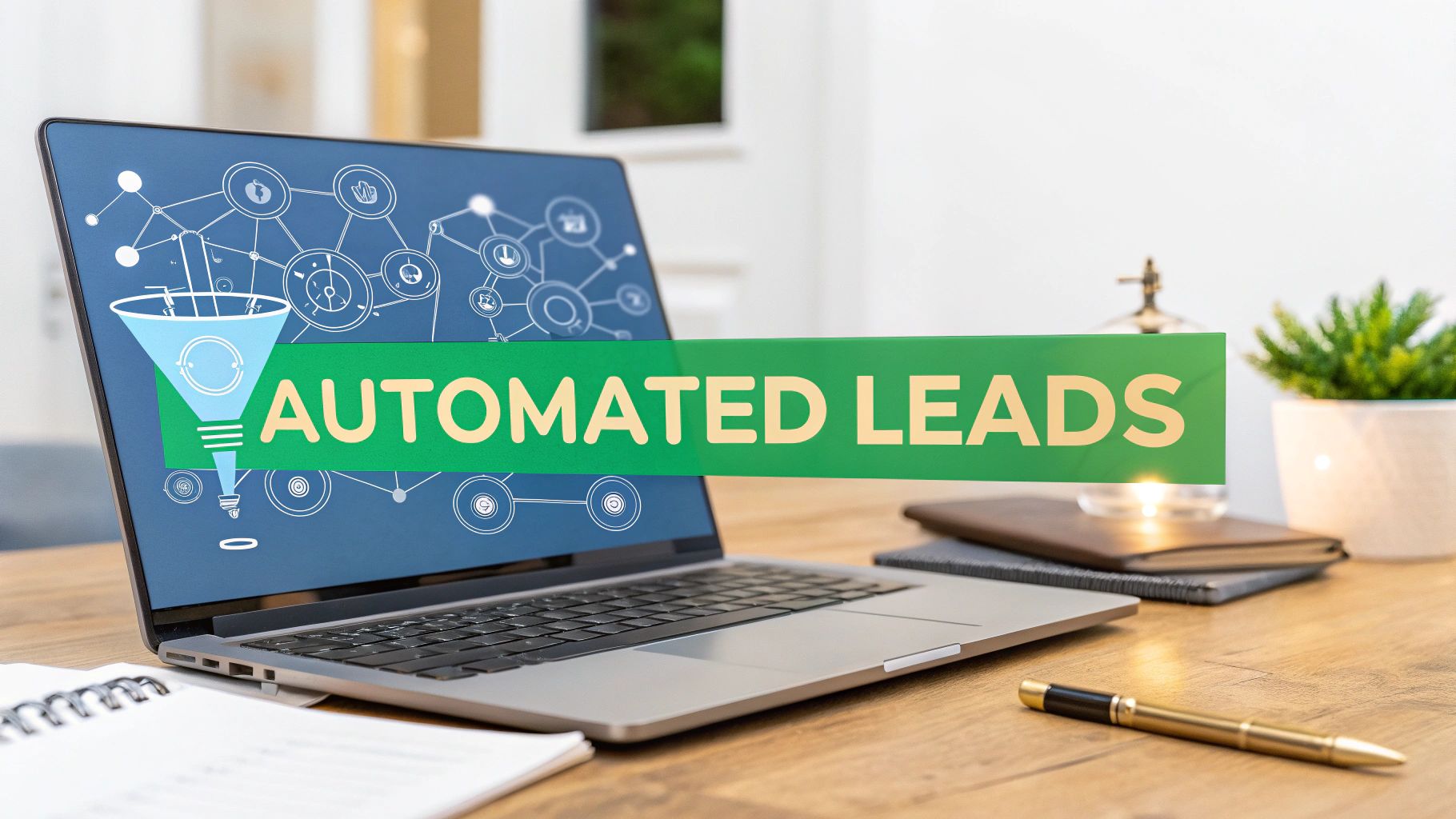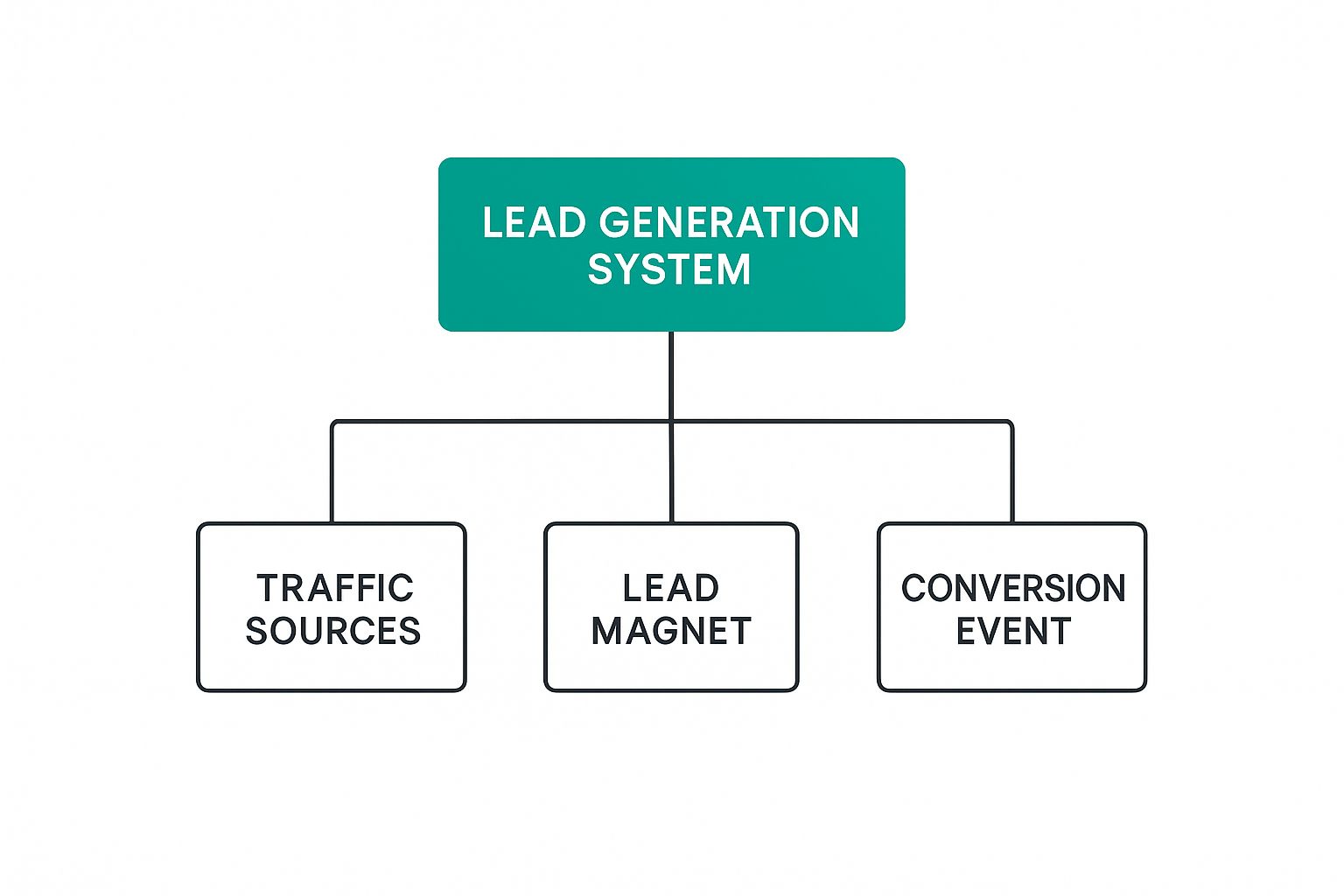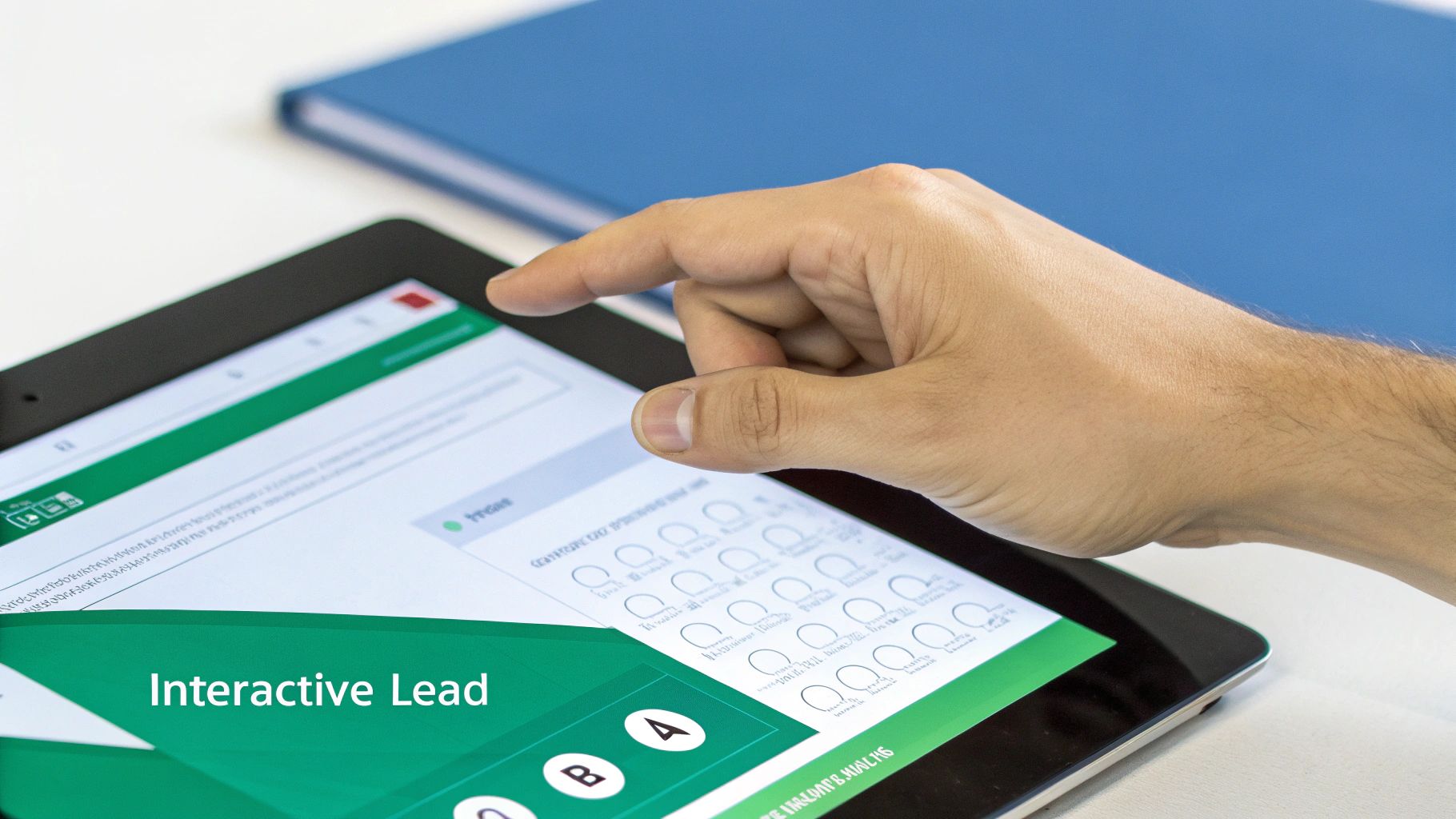Build Your Automated Lead Generation System
Stop chasing leads. Learn how to build an automated lead generation system that attracts, nurtures, and converts customers 24/7. Start growing predictably.

A lead generation system isn't just a tactic; it's an automated engine designed to attract, capture, and qualify potential customers on autopilot. It’s the difference between running one-off campaigns and building a predictable, scalable flow of high-quality leads for your business.
The Hidden Costs of Manual Lead Generation
That constant, grinding hustle for the next lead? It's completely exhausting. You're stuck on a hamster wheel, bouncing between isolated campaigns, endless cold outreach, and results that are all over the place.
One month you’re celebrating a win, the next you’re wondering where everyone went. This feast-or-famine cycle isn't a sustainable way to grow a business—it's a fast track to burnout. I’ve been there, pouring hours into activities that felt productive but delivered zero predictability. The problem isn’t a lack of effort; it's the lack of a system.
The Linear Work Trap
Most businesses are stuck doing linear work, directly trading their time for results. Send 50 cold emails, and maybe you get one meeting. Run a one-week ad campaign, get a handful of sign-ups, and then it’s back to square one next month. It’s an endless loop of manual labour that can never scale beyond the hours you’re willing to put in. This approach isn't just inefficient; in a world that rewards automation, it's a strategic dead end.
The market has already made its move, making this manual approach even riskier. The European lead generation solution market was valued at US 2,705.03 million by 2028. This growth is being fuelled by massive digital adoption. To put that in perspective, over 67.8 million Germans are expected to be active on social media by 2025—that's more than 80% of the population. This shift makes automated, digital-first systems an absolute necessity. You can learn more about the market's growth and what it means for your business.
From Doing to Building a System
The most powerful shift you can make is from doing lead generation to building a lead generation system.
Think of it this way. You can either spend your days fetching buckets of water from a well (doing the work), or you can invest the time to build a pipeline that delivers water directly to your house (building a system). The upfront effort is greater, but the payoff is a predictable, automated flow that works for you 24/7. This is the only way to escape the feast-or-famine cycle for good.
The graphic below shows a typical funnel in the DACH region, highlighting the various touchpoints that you need to systemise.

As you can see, a modern customer journey has multiple stages, from initial awareness to the final conversion. Each one of these can—and should—be automated and optimised as part of a larger, cohesive system.
Why Thinking in Systems Is Your Ultimate Growth Hack

Let’s talk about the single biggest mental shift you need to make to get off the lead generation hamster wheel for good. Too many businesses are stuck in a linear, task-based rut. Run an ad, get a lead, follow up. It's a direct, exhausting trade of your time and effort for a result that vanishes as soon as you stop pedalling. This is the fast track to burnout, not sustainable growth. I’ve been there, and it’s a frustrating cycle of manual tasks that never compound. You wrap up one campaign, and the next day, you’re right back at square one with nothing to show for yesterday’s work but a small list of contacts.
A lead generation system, on the other hand, is a completely different animal. It’s a web of interconnected, automated processes that work together on autopilot to deliver predictable outcomes. You stop doing the work and start designing the machine that does the work for you. By investing time upfront to build a machine, you create an asset that runs 24/7, attracting, engaging, and qualifying leads even while you sleep. Your role shifts from manual labour to strategic oversight—monitoring performance, tweaking components, and scaling the output. This isn't just about stringing a few tools together; it’s a complete strategic philosophy that brings predictability and sanity back to your growth efforts.
Moving from Engine to Engineer
Imagine spending the time to build a machine just once. You carefully design it, assemble all the right parts, and flip the switch. From that moment on, it runs 24/7, attracting, engaging, and qualifying leads for you, even while you sleep. That’s the real power of thinking in systems.
You stop being the engine that powers the business and become the engineer who designed it. Your role shifts from manual labour to strategic oversight—you're monitoring performance, tweaking components for better efficiency, and deciding when to scale the output. This isn't just about stringing a few tools together; it’s a complete strategic philosophy.
The core difference is that a campaign is an event with a start and an end date. A system is a permanent business asset that you build, own, and optimise over time.
This distinction is absolutely crucial. Campaigns give you temporary spikes in activity, but a system creates a rising tide of predictable growth. One is like renting a tool for a weekend project; the other is like building a workshop in your garage.
The Predictability Factor
Here’s a slightly controversial take: your obsession with one-off campaign wins is probably holding you back. A massive success from a viral post or a lucky ad feels great, but you can't build a business on luck. Predictability is the real currency of growth.
A well-designed lead generation system delivers that predictability. It transforms chaotic, random lead flow into something you can actually forecast.
- You know your numbers: You can confidently predict how many leads you'll generate next month based on specific inputs, taking the guesswork out of planning.
- You can scale methodically: Want more leads? You don't just throw money at the wall and hope. You increase the fuel to a specific part of your machine (like ad spend or content output) and know what the result will be.
- You remove yourself from the equation: The system runs without your constant intervention, freeing you up to work on the business instead of being trapped in it.
Building this machine requires an upfront investment of time and strategy, no doubt. You have to map out every single stage, from how you first attract a visitor to how you deliver your lead magnet and nurture that new relationship.
Ultimately, this is about building a scalable asset that generates value long after the initial work is done. It’s the only path to sustainable, long-term growth that doesn’t require you to clone yourself.
The Four Pillars of a Powerful Lead Generation System
A powerful system isn't born from complexity. Forget those overwhelming diagrams and confusing jargon you see online. At its heart, any effective lead generation system is built from four simple, interlocking parts that work together to create a predictable flow of new customers.
Think of it like building with LEGOs. You don’t start with a thousand specialised, weirdly-shaped pieces. You start with the fundamental bricks. Once you master how these simple components connect, you can build anything you can imagine.
This diagram shows how these four simple pillars form the foundation of your entire system.

Each element feeds directly into the next, creating a smooth, automated journey from a complete stranger to a potential customer. Let's break down each of these foundational pillars.
To give you a clearer picture, here’s a quick overview of how these components fit together.
Core Components of a Lead Generation System
| Component | Primary Function | Example Tactics & Tools |
|---|---|---|
| 1. Traffic Sources | To attract and direct your ideal audience towards your system. | SEO (e.g., Ahrefs), Paid Ads (Google/Facebook Ads), Social Media Marketing (LinkedIn), Partnerships |
| 2. Lead Magnet | To offer something of genuine value in exchange for contact information. | Interactive Quizzes, ROI Calculators (e.g., Outgrow), Ebooks, Checklists, Webinar Sign-ups |
| 3. Nurturing Sequence | To build trust and guide leads towards the final goal. | Automated Email Sequences (e.g., Mailchimp, ActiveCampaign), Retargeting Ads, Case Studies |
| 4. Conversion Event | The specific, valuable action you want a qualified lead to take. | Booking a Demo (e.g., Calendly), Requesting a Quote, Starting a Free Trial, Making a Purchase |
This table lays out the roadmap. Now, let's explore what makes each stop on that map so important for building a system that actually works.
Pillar 1: Traffic Sources
This is where your journey begins—the starting line. Traffic sources are simply the channels where your ideal customers are already spending their time. The goal isn't to be everywhere at once; it's about being in the right places, directing a steady stream of relevant people towards your system.
Your job is to pick a few key channels and really focus your efforts there. This could mean:
- Organic Search (SEO): Writing helpful blog posts that answer the exact questions your audience is typing into Google.
- Social Media: Actually talking to your community on platforms like LinkedIn or X (formerly Twitter), not just broadcasting.
- Paid Advertising: Running laser-focused ads on platforms like Google or Facebook to reach a very specific group of people.
- Partnerships: Teaming up with other businesses who already have the trust of the audience you want to reach.
The trick is to view these channels not as one-off campaigns, but as taps you can turn on whenever you need to fuel your system.
Pillar 2: The Lead Magnet
This is the absolute heart of your system and, frankly, where most businesses drop the ball. A lead magnet is that irresistible, high-value offer you provide in exchange for someone's contact details. It's the handshake that starts the conversation.
A weak lead magnet—like a generic "subscribe to our newsletter" button—is like a limp, unenthusiastic handshake. It makes no impression. A powerful lead magnet, on the other hand, solves a specific, urgent problem for your audience, right then and there. For a deeper dive, check out our complete guide on using a marketing funnel builder to weave your lead magnets into a seamless journey.
A truly great lead magnet doesn't just give information; it delivers a tangible result or a moment of clarity. This is why interactive tools like quizzes or calculators often outperform static PDFs by a massive margin.
I remember a B2B SaaS company I worked with that struggled for months with low webinar sign-ups. Their offer was a vague "Learn About Our Platform." After a bit of brainstorming, they switched to an interactive "ROI Calculator" that showed potential customers exactly how much money they could save. Their conversion rate tripled almost overnight. Why? Because the new lead magnet delivered immediate, personalised value.
Pillar 3: The Nurturing Sequence
Once you've earned that email address, the real work begins. The nurturing sequence is an automated series of communications—usually emails—designed to build trust, provide even more value, and gently guide the lead toward the next step.
Think of this as your system's automated relationship-builder. It's your chance to prove you understand their challenges and are the right one to help solve them. A good sequence might share relevant case studies, answer common questions, or provide more helpful resources related to the original lead magnet.
Pillar 4: The Conversion Event
Finally, we arrive at the destination: the conversion event. This is the specific action you want your now-qualified lead to take. It’s the entire point of your lead generation system. It’s not always a direct sale, especially in B2B or high-ticket sales.
The conversion event should feel like the logical, natural next step in their journey with you. This could be:
- Booking a demo call
- Requesting a custom quote
- Starting a free trial
- Making a purchase
When these four pillars are built and connected properly, you shift from the frantic chaos of chasing leads to the calm predictability of an automated system that works for you, 24/7.
Using Interactive Content to Power Your System

Let’s be honest for a second. The old playbook of static PDFs and generic checklists? It’s losing its punch. In a world drowning in content, the secret to a high-performing lead generation system isn't just about dishing out value—it's about getting your audience to actively participate in the process.
This is where interactive content comes in, acting as the supercharged engine for your entire system. Things like quizzes, calculators, and assessments do something a 50-page ebook simply can't. They turn a passive browser into an engaged participant.
When someone takes a quiz, they aren't just downloading a resource; they are co-creating a personalised result. This small psychological shift is incredibly powerful. It builds a tiny bit of investment and sparks curiosity, making the exchange of an email address feel like the most natural next step.
My First Interactive 'Aha' Moment
I'll never forget the first interactive quiz I built. It was a simple diagnostic tool to help consultants pinpoint the bottlenecks in their client acquisition. Before that, my go-to lead magnet was a detailed, heavily researched ebook. The ebook got a slow trickle of downloads, but the leads were almost always lukewarm.
The moment I launched the quiz, everything changed. The conversion rate from visitor to lead jumped by over 400%. But that wasn't the real game-changer. The leads weren't just more numerous; they were dramatically better. These were people who had actively diagnosed their own problems and were now ready for a conversation about the solution.
That experience taught me a crucial, if slightly controversial, lesson.
Most businesses obsess over the quantity of information in their lead magnets, believing a bigger ebook equals more value. But the best lead magnets focus on the quality of the result they deliver. A two-minute quiz that gives someone a moment of clarity is ten times more valuable than a fifty-page PDF that gets saved to a desktop and forgotten.
The data absolutely supports this. In the German B2B market, for example, businesses are quickly embracing AI-driven tools like HubSpot and Salesforce to create these kinds of hyper-personalised experiences. A recent analysis pointed out that combining data sources—especially the zero-party data you get from a quiz—allows companies to tailor their messaging with stunning precision, which naturally leads to higher conversion rates. You can discover more insights on German B2B trends and see how personalisation is fuelling growth.
Why Interaction Creates Better Leads
Interactive content is so effective because it gathers what we call zero-party data. This is information a potential customer intentionally and proactively shares with you. Unlike behavioural data scraped from cookies, this is explicit insight into their goals, pain points, and needs.
Here’s why that’s pure gold for your lead generation system:
- Instant Segmentation: Based on their answers, you can automatically sort leads into different buckets. Someone who says their biggest challenge is "finding new clients" can be dropped into a completely different nurture sequence than someone whose problem is "closing deals."
- Hyper-Personalised Follow-Up: Your first follow-up email is no longer a generic "Thanks for downloading." Instead, it becomes, "Based on your quiz results, it looks like you're struggling with X. Here's a case study on how we helped another company solve that exact problem."
- Higher Sales Qualification: By the time a lead even talks to your sales team, you already have a dossier of information on them. This makes the first sales call far more relevant and effective from the get-go.
This entire approach—creating genuine value right from the start—is the foundation of a modern, effective lead generation system. It's not just about grabbing a name and an email; it's about starting a meaningful conversation based on a real understanding of what the other person actually needs. You can see several real-world examples of how we've built these tools for clients by exploring our past interactive lead generation projects.
100% Free Lead Magnet Audit
Our AI analyzes your website and delivers custom growth strategies in seconds.
How to Measure and Optimise Your System for Growth
A lead generation system you can’t measure is really just a shot in the dark. Its real power isn't in the shiny tools or complicated workflows; it's in being predictable. And that predictability comes from one place: the data.
But let’s be clear. I’m not talking about those vanity metrics that make you feel productive but don't actually push your business forward. Forget obsessing over website traffic, social media likes, or even the total number of leads you've gathered. Those numbers are usually a distraction.
Here’s a hard lesson I’ve learned over the years: focusing too much on the top of your funnel can slowly poison your business. It tricks you into celebrating activity instead of actual progress, leaving you with a bloated list of unqualified leads who were never going to buy in the first place. We need to focus on what truly matters.
Metrics That Actually Move the Needle
To get a real sense of your lead generation system's health, you only need to track a handful of key performance indicators (KPIs) that show how efficient it is from start to finish. I personally keep a simple dashboard that monitors just a few critical numbers.
These are the metrics that tell the real story:
- Lead Velocity Rate (LVR): This tracks the month-over-month growth in qualified leads. It’s a forward-looking metric that’s far better at predicting future revenue than just looking at last month’s sales figures.
- Cost Per Qualified Lead (CPQL): How much does it really cost you to get a lead who is both a good fit and shows genuine interest? This number cuts through the noise of cheap, low-quality leads and tells you if your acquisition strategy is actually profitable.
- Stage-by-Stage Conversion Rates: This is your most powerful diagnostic tool. It breaks down your entire system into small, manageable steps and shows you exactly where people are dropping off.
The goal isn't just to generate leads; it's to manufacture qualified sales opportunities at a predictable cost. These metrics show you how well your machine is doing its job.
Tracking these numbers helps you think more like an engineer and less like a marketer. You stop guessing and start diagnosing, constantly testing and fine-tuning each part of your system for the best possible results.
Finding the Bottleneck
Years ago, I was running a system that was bringing in plenty of leads, but almost none of them were booking sales calls. My top-of-funnel numbers looked fantastic, but the final output was terrible. Frustrated, I finally sat down and mapped out every single step, measuring the conversion rate between each one.
The problem was hiding in plain sight. The conversion rate from someone downloading our guide to them opening the second email in our follow-up sequence was shockingly low—under 15%. That was the bottleneck. The rest of the sequence was pointless if nobody was even getting that far. For a more detailed look at this journey, our guide on the B2B sales funnel breaks down each critical stage.
We made one tiny tweak. We changed the subject line of that second email and added a compelling question related to the guide they'd just downloaded. The result? The open rate for that email shot up to over 45%, and the number of sales appointments booked jumped by 30% almost overnight.
That’s the power of measurement. It lets you find the one loose screw rattling the entire machine, tighten it, and see an immediate boost in performance. Without data, you’re just hoping things get better. With it, you have a clear roadmap to predictable growth.
Common System-Building Mistakes to Avoid
Building a powerful lead generation system is an incredible feeling, but the path is littered with pitfalls. I know because I’ve fallen into pretty much every single one of them. The goal here isn't to scare you; it’s to give you a map of the minefield so you can walk right through it.
The most common and seductive mistake? Overcomplicating everything from the start. It's easy to get excited and immediately sign up for five different tools, trying to piece together a complex, multi-branching workflow. It looks impressive on a whiteboard, but it often collapses under its own weight in the real world. Your first system should be brutally simple: one traffic source, one great lead magnet, one follow-up email sequence. That’s it.
The Disconnected System
Another classic error is building all the parts in isolation, without thinking about how they're supposed to connect. I see this happen all the time, and it leads to two major problems that silently kill your results.
- The "Party Host" Failure: This is when you create a brilliant, high-converting lead magnet but have absolutely no follow-up nurture sequence attached. It's the digital equivalent of inviting someone to a great party, getting their details at the door, and then completely ignoring them for the rest of the night. You did all the hard work to get their attention, only to immediately squander the trust. Remember, a lead goes cold in hours, not weeks.
- The "Freebie Seeker" Magnet: This one is more subtle but just as deadly. It’s the danger of creating a lead magnet that isn’t aligned with your core paid offer. A perfect example is a marketing agency offering a "50 Free Social Media Post Ideas" PDF. Sure, it might get thousands of downloads, but it attracts junior marketers and small business owners looking for free templates, not the marketing directors with a budget who are their ideal clients. This just fills your list with people who have no intention of ever buying what you actually sell.
The purpose of a lead magnet isn't just to get an email address; it's to attract a specific type of person and pre-qualify them for the next step in their journey with you.
If you suspect your lead magnet is attracting the wrong crowd or simply isn't connecting with your core offer, you've found a critical system failure. Getting an impartial look can be a game-changer. A free tool like Magnethive can run a full lead magnet audit, giving you a clear report with AI-powered ideas for interactive magnets that attract better-qualified leads.
The Mindset Mistake
Finally, there’s the underlying mindset that sabotages most attempts at building a proper system. Too many people approach this with a linear, task-based mentality. They see "build a landing page" or "write an email sequence" as a one-and-done project to check off a list.
A lead generation system isn't a project; it's a living, breathing asset. It requires you to think like an engineer, not just a marketer. You build the machine, turn it on, and then your job becomes monitoring its performance, identifying bottlenecks, and continuously optimising each component for better output. It works for you predictably, on autopilot, because you designed it that way.
This shift from "doing tasks" to "optimising a machine" is the true secret to creating a system that generates leads while you get back to growing your business.
Your Top Questions Answered
You’ve got the blueprint, which is fantastic. But as you start to build, questions are bound to pop up. Let’s tackle some of the most common ones I hear from people just like you, based on years of hands-on experience building these systems from the ground up.
How Much Does It Cost to Build a Lead Generation System?
The honest answer? It really depends. But the good news is you don’t need a massive budget to get started. You can build a surprisingly powerful system with top-notch tools for under €100 a month. That covers your landing page builder, your email marketing service, and an interactive content tool.
The biggest investment at the start isn’t cash—it’s your time. The real work is in understanding your ideal customer inside and out, then using that insight to map out your strategy. Once the system proves itself and you see a clear return, you can then reinvest in more advanced platforms for CRM, automation, and analytics.
How Long Does It Take to See Results?
This is the big one, isn't it? I’ll be straight with you: if someone promises you a flood of perfect leads overnight, they're selling snake oil. While a well-promoted quiz or calculator can start pulling in leads within the first week, the entire system needs a little time to find its rhythm.
Expect to see a consistent, predictable flow of qualified leads within 60 to 90 days. This timeframe is realistic because it gives you enough data to test your traffic sources, tweak your lead magnet, and refine your email sequences. We’re aiming for sustainable growth here, not just a one-off sugar rush.
Can This System Work for a Service-Based Business?
Absolutely. In fact, I’d argue it works even better for service businesses. Why? Because selling a service is all about trust, and this system is designed to build that trust automatically, and at scale.
Think of your lead magnet not as a boring PDF, but as a genuinely useful diagnostic tool that proves your expertise from the first click.
- A business consultant could offer a "Business Bottleneck Assessment".
- A web design agency might create a "Website Performance Grader".
- A financial advisor could build a "Retirement Readiness Calculator".
From there, your automated email sequence continues the conversation, sharing valuable insights, case studies, and positioning you as the only logical choice. The system does the heavy lifting of qualifying leads, meaning you only spend your precious time on calls with people who are already warmed up and ready to talk business.